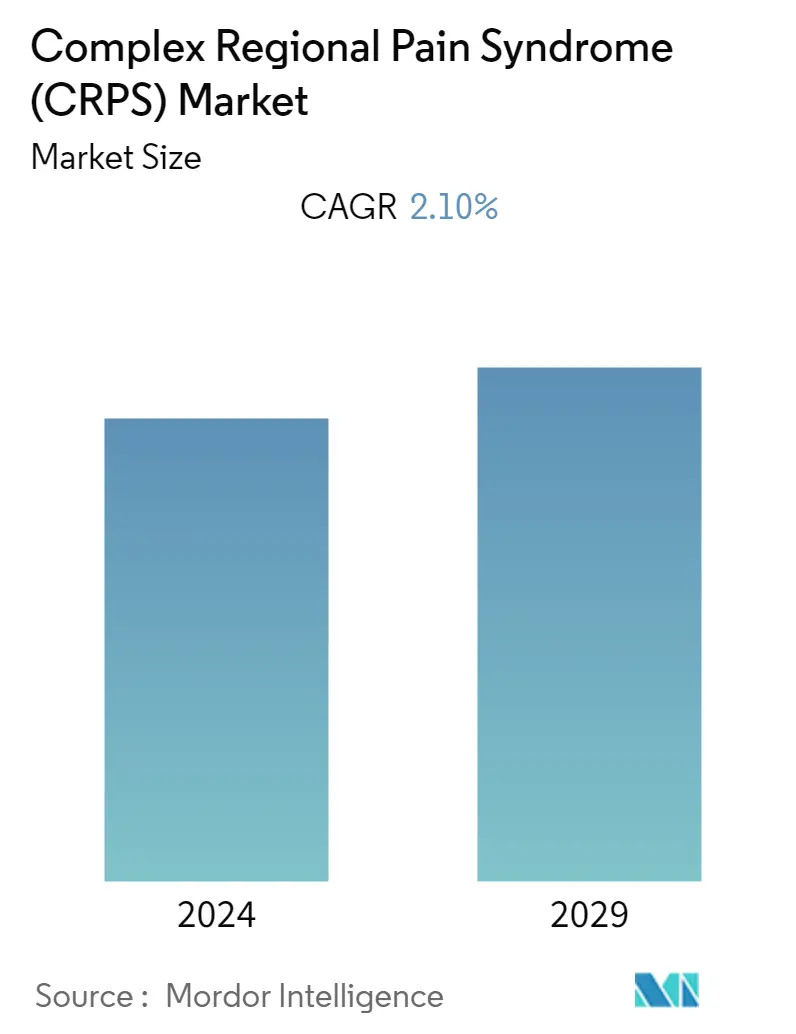Market Size of Complex Regional Pain Syndrome (CRPS) Industry

| Study Period | 2019 - 2029 |
| Base Year For Estimation | 2023 |
| CAGR | 2.10 % |
| Fastest Growing Market | Asia Pacific |
| Largest Market | North America |
| Market Concentration | Low |
Major Players
*Disclaimer: Major Players sorted in no particular order |
Need a report that reflects how COVID-19 has impacted this market and its growth?
Complex Regional Pain Syndrome (CRPS) Market Analysis
The complex regional pain syndrome (CRPS) market is expected to register a CAGR of 2.1% over the forecast period.
The complex regional pain syndrome market has been significantly impacted by the COVID-19 pandemic, particularly in its early stages. COVID-19 infection causes peripheral nerve lesions, including small fiber neuropathy. The potentially disabling complication of any peripheral nerve lesion is complex regional pain syndrome (CRPS). For instance, a study report published by PubMed in November 2021, stated that systemic hyperinflammation in severe COVID-19 may contribute to peripheral and central neuronal sensitization, which may increase the risk of developing complex regional pain syndrome (CRPS). As a result of the COVID-19 effect on neuronal sensitization, the demand for drugs used in complex regional pain had witnessed a positive impact. Thus, the impact of COVID-19 on the market was adverse in its initial stages owing to supply chain constraints. However, as the pandemic has subsided, the market is expected to have stable growth during the forecast period of the study.
The major growth drivers of the complex regional pain syndrome market over the forecast period are the rising incidence of complex regional pain syndrome and the growing number of patients suffering from chronic pain. For instance, as per the study published by PubMed in September 2021, the worldwide prevalence of complex regional pain syndrome varies from 5.5 to 26.2 per 100,000 people per year. Also, as per the report published by PubMed in July 2021, the general CRPS incidence rate was 15.83 per 100,000, with 19.5 for type 1 and 12.1 for type 2. Also, the increase in chronic pain among patients influences the market growth. For instance, as per the report published by PubMed in September 2021, the prevalence of pain is 60%, 48% for chronic pain, and 10% for neuropathic pain among chronic kidney disease patients. Thus, with the significantly high incidence rate and increase of chronic pain among patients, the demand for complex regional pain syndrome treatment is expected to increase, which is anticipated to have a positive impact on the growth of the studied market during the forecast period.
Moreover, with increasing product launches the market is expected to experience growth during the forecast period of the study. For instance, in October 2021, PharmaTher Holdings Ltd. received the United States FDA orphan drug designation (ODD) for ketamine in the treatment of complex regional pain syndrome (CRPS), a rare chronic pain and inflammatory condition following an injury to a limb (arm, leg, hand or foot).
Hence, due to the aforementioned factors such as the rising incidence of complex regional pain syndrome, the growing number of patients suffering from chronic pain, and increasing product launches, the market is expected to experience growth over the forecast period of the study. However, a lack of awareness about the target disease in developing countries is expected to restrain the complex regional pain syndrome market during the forecast period.
